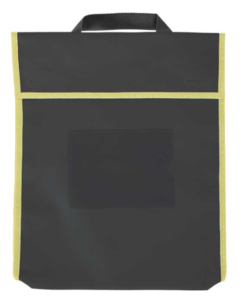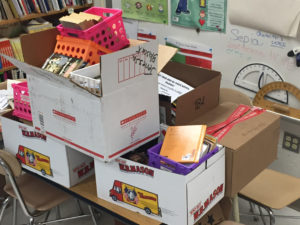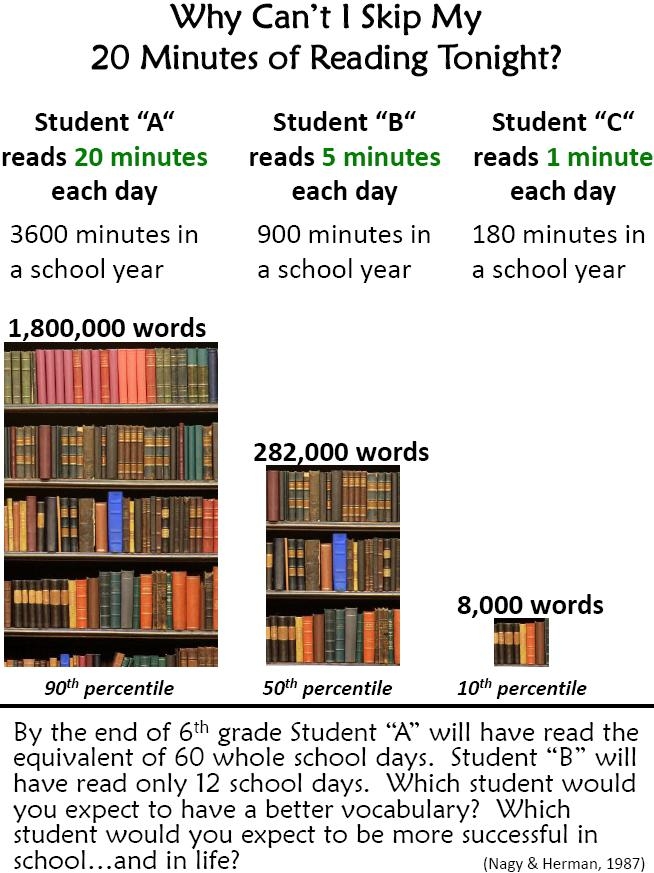Viewing: independent reading
May 28, 2019
Finishing May in 209
The school year may be wrapping up, but that doesn’t mean that we’re slowing down in room 209! Here are some updates on what we’ve been working on:
Reading
 This is the time of year when I administer the spring round of DRAs to students in order to get an updated reading level for students. I’ll be sure to share your child’s spring reading level so that you can help to match your child with just-right books during the summer. Remember, your child doesn’t have one single level and, instead, has a range of just-right levels. There are many factors that an impact the suitability of texts, including familiarity with the topic, character voice, the sequencing of events in a text, etc. Also, several weeks ago, students started bringing home black and yellow book bags (pictured to the right) with just-right texts from school. While they’re still encouraged to enjoy their own books from home, using this book bag helps to ensure that they are coming home with a book that’s appropriate for their own level when reading at home. I’ve enjoyed getting to discuss with students the books they’re reading and enjoying at home!
This is the time of year when I administer the spring round of DRAs to students in order to get an updated reading level for students. I’ll be sure to share your child’s spring reading level so that you can help to match your child with just-right books during the summer. Remember, your child doesn’t have one single level and, instead, has a range of just-right levels. There are many factors that an impact the suitability of texts, including familiarity with the topic, character voice, the sequencing of events in a text, etc. Also, several weeks ago, students started bringing home black and yellow book bags (pictured to the right) with just-right texts from school. While they’re still encouraged to enjoy their own books from home, using this book bag helps to ensure that they are coming home with a book that’s appropriate for their own level when reading at home. I’ve enjoyed getting to discuss with students the books they’re reading and enjoying at home!
Writing
This year, we flip-flopped our expository writing unit and narrative writing unit in order to take advantage of some teachable moments earlier in the year. So this spring, we’ve been working on narrative writing. Our guiding idea has been the thought that “Writers write about what they know.” Our lessons have been based on this idea, including activities that brainstorm experiences based on feelings, descriptions, etc. Some time ago, students wrote a narrative story without any pre-teaching. We called this the “cold write” story. This allowed me to see what skills I needed to focus on, and it is allowing us to focus more on how to improve a story through revising and editing.
Math
We’re just finishing up our unit on geometry. The homework from late last week served as a review for the unit assessment, and I’ve enjoyed working on this unit in class. We’ll soon start our final unit, which focuses on measurement and data.
Social Studies
A million thanks to you for your donation of a dry erase globe to celebrate teacher appreciation week! As you may have seen on Twitter last week, we have been working on latitude and longitude, and the globe was a great tool for illustrating this abstract concept! We also took a few minutes to make you a special thank you video, as you may have seen online.
Thank you so much, families, for our new dry erase globe!What a terrific teacher appreciation gift!We’ve had fun using it to learn about latitude and longitude! #AskYourKid about CT’s coordinates. We also enjoyed making a stop motion animation to show some of our work! 333frames! pic.twitter.com/QYhrfsGEJf
— Jon Moss (@MossTeaches) May 24, 2019
Science
We’ve been learning about plants and animals in class. The bulk of our study has focused on how animals use their senses to survive. Students learned about sensory processing by experimenting on how they perceive sensory input, and they extended their learning by working with mealworks. We learned about how otters stay warm in icy cold waters, and students worked to build their own insulated containers (based on how otters use a later of air to stay warm). In the coming days, we’ll shift to learning about how plants also have specific parts that are needed in order to survive.
Posted in Class Updates|By Jon Moss
December 11, 2018
Redesigning Our Class Library

When you visited our room for your fourth grader’s parent-teacher conference, you may have seen a table that was filled with boxes upon boxes, all filled with books. No, this isn’t our new freestyle shelving system. Rather, it’s a work in progress as we tackle a months-long project to reorganize our class library.
The project began at the start of the school year. This year, our school’s goal is to harness the power of independent reading by (a) ensuring that structured independent reading time allows students to focus on specific skills, and (b) helping students to read books that are at an appropriate reading level for them. (At our conference, you should have received a packet with information about your fourth grader’s reading level. If you haven’t yet gotten one, it will be coming home tomorrow. Please ask your kids for them, as they’re now in their mailboxes waiting to go home.) In order to help students to find texts at their level, we’ve tackled a complete revision of our class library.
This started a few months ago with the forming of our class library committee. It was open to any and all students who wanted to participate. We ended up with 11 students, which has been terrific! Our first task was to weed through our existing library and remove books that were either in poor condition or were unlikely to grab the interest of prospective readers. I knew we needed plenty of room to add more books, so we were pretty ruthless in removing old books. (I hate to throw away books, so many were given to students.) Next, the kids went shopping, both in the Scholastic Book Club catalogs and at our school’s book fair. They had the shopping cart, and Mr. Moss had the credit card! Soon, we had a few hundred books to add to our library (and Mr. Moss’s splurge budget for the next few months shrunk! HA! :-D)
Our next step was to catalog and level our books. That serves two purposes. First, we’ll be left with a searchable spreadsheet that will allow students to look for books by particular authors, books at a particular level, or books with a particular title. Our library won’t be organized by these factors, necessarily, so having a resource within which they can search will be valuable! Also. students are working to level the books. All books have a level, which measures the text complexity. That’s more than just how hard the WORDS are, and also includes style of writing, character situations, chronology, prior knowledge required, etc. We’re looking up the reading levels based on what we find on Scholastic’s site, using an app, etc. That information is getting added to the catalog spreadsheet.
Our next step, once all the books are cataloged and leveled will be to print out labels, both for the inside covers of the book and for sign-out cards that we’ll use to keep track of who has which book checked out. Once that system is in place, you can expect students to start to bring home books at their level. Stay tuned!
More cool news is that we’ll be receiving a leveled book cart from the district in the coming months. What’s cool about this is that it will be organized differently from our library. While our class library will be organized by theme, series, author, topic, genre, and other factors (with books of a variety of levels within each section), the book cart will be organized by level, with books of different topics within each level. So when students want to search by topic, they can begin in our library. When they want to search by level, they can begin with the cart.
This wouldn’t be possible without the incredibly hard work of our class library committee volunteers. They’ve worked tirelessly to help us reach this point. Now we’re in need of more help (from adults). I’m looking for some volunteers to help us with the leveling of books. Some parts can be done in school, with the committee members. But for all of you who are unable to come during the day but still want to help, here’s an opportunity for you to help us from the comfort of your own home! If you’d like to volunteer, please email me and tell me whether you’re looking for a daytime slot (M, T, or W between 1:30-2:00 – later on, other slots will open up as well) or if you’d like an at-home job, which can be done at your convenience. As usual, I’ll follow-up with you to let you know what’s available, since we may have more volunteers than needed. (What a GREAT problem to have!) Thank you for considering!
Posted in Class Updates|By Jon Moss
November 8, 2016
Independent Reading at Home
 I’m in a workshop about reading instruction, and we’re discussing independent reading. I’ve come across a few ideas that I wanted to share with you! One was this simple graphic (right) that shows the value of independent reading at home. Another point was a simple quote:
I’m in a workshop about reading instruction, and we’re discussing independent reading. I’ve come across a few ideas that I wanted to share with you! One was this simple graphic (right) that shows the value of independent reading at home. Another point was a simple quote:
“When you dismissal the book a child is reading, you are dismissing the child.”
I often hear parents share comments like “I want my child to read real books. All he reads is Captain Underpants!” When we criticize the topic, series, or rigor of a text that a child has chosen, we are communicating a vote of “no confidence” in that child’s judgment. I’ve seen countless times in which an adult’s seemingly off-hand comment deflates a student’s confidence in reading or love of reading. Let’s all be sure to choose our words wisely.
Another important point worth sharing is the idea that we need a balance between giving students autonomy of choosing a book and ensuring that students are choosing a “just right” book at their independent reading level. There is merit to both, certainly, and an ideal balance might involve students choosing a book within a set of books at their reading level. Our school (and, in specific, our classroom) is focusing on improving reading engagement. Reading engagement is the degree to which students enjoy and value reading. There are different ways we support reading engagement, but no matter what, we want students to enjoy what they’re reading, when at all possible.
Posted in Class Updates|By Jon Moss
September 27, 2016
Independent Reading in Fourth Grade
 There are so many important things for us to cover this year, but one of the most critical is helping students to build a love of reading! Teachers work to ignite this spark for students (or, more appropriately, to help them to ignite that spark themselves), and we have several ways of helping students along. First, throughout the year, you’ll see different ways in which I’ll work to match students with appropriately-leveled books. This is something that, as time goes on, your student will learn to do for himself or herself to a certain extent. Another focus is on building independent reading skills. When we have independent reading time in class, everyone is reading a book that’s right for them and we have discussed (and will continue to discuss) some of the many strategies that successful readers use.
There are so many important things for us to cover this year, but one of the most critical is helping students to build a love of reading! Teachers work to ignite this spark for students (or, more appropriately, to help them to ignite that spark themselves), and we have several ways of helping students along. First, throughout the year, you’ll see different ways in which I’ll work to match students with appropriately-leveled books. This is something that, as time goes on, your student will learn to do for himself or herself to a certain extent. Another focus is on building independent reading skills. When we have independent reading time in class, everyone is reading a book that’s right for them and we have discussed (and will continue to discuss) some of the many strategies that successful readers use.
Several parents have inquired about a nightly reading log, so I want to take a moment to share my philosophy about reading logs. I don’t use formal reading logs for students for a few reasons: First, it turns the reading into a chore. I’d rather a student enthusiastically read for 20 minutes a day and enjoy it than “force” themselves to read for 30 minutes because they need to reach that exact amount of time for the reading log. If the end goal is for students to LOVE to read, then it should not be tracked as a homework assignment. (That said, it IS a homework assignment. More on that in a moment.) Second, knowing that parents have busy lives, I understand that there may be some nights when kids read a lot, and some nights when there may be less reading. I’d hate to put parents into a position in which they feel that they need to lie on a reading log to avoid their child getting penalized for a tough family schedule that was outside the child’s control. You have enough to juggle, particularly because I’m aware that some of my homework assignments (particularly the computer-based activities) may take more time than conventional worksheets. (I hope you feel that the payoff is worthwhile!)
By now, half of you are probably cheering for a year without reading logs, and half of you are appalled that I’m letting your fourth grader “off the look” when it comes to nightly reading. Let me assure you: I’m not. My expectation is that students read each night, hopefully about 30-40 minutes. That’s in line with all fourth grade classrooms. What’s different is that I’m asking them to be accountable to you, as the people in charge at home who see the whole picture (in terms of what they’re reading, how they’re feeling about the experience, what else is going on, etc.) as opposed to making them accountable to me (where I am disconnected from what’s happening after school). If you’re feeling that your fourth grader is reading each night and is benefiting from the experience, that’s terrific! But if you find that your child’s “willful” reading lasts only five minutes before you need to push more, or if your child has to be poked and prodded to read a book, or if you have any other concerns, I hope you’ll reach out to me so we can talk more. But to summarize: Your child should normally be reading about 30-40 minutes each night, and I ask that you help to ensure this happens on a regular basis). But I’m just an email away if you have questions or concerns.
A few side notes: (1) As I write this, I’m realizing that I haven’t discussed this enough with the students. I’ll fix that tomorrow! (2) As the year progresses, there may be specific reading challenges in which I send home a log, but those will be the exceptions, not the norm. (3) When we meet for our fall parent-teacher conferences, I’ll have completed our first reading assessment with your child, and I’ll be able to give you his or her independent reading level (which can guide you and you and your child choose books at the library or bookstore). If you’re interested in knowing sooner, I’ll have the results by Halloween time, and again, I’m just an email away!
Please feel free to contact me with any questions!
Posted in Class Updates|By Jon Moss
